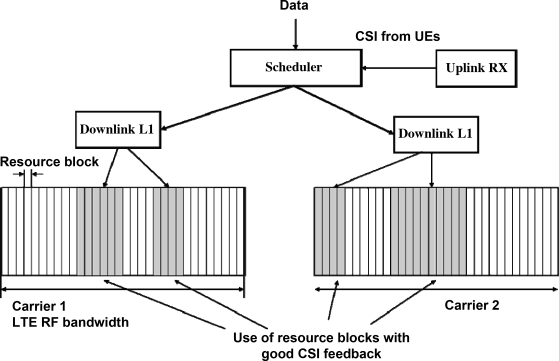4.5 Performance
In this section the benefits from the carrier aggregation are investigated, both theoretically and also based on simulations. The gains in carrier aggregation come from the following key implications:
- Load balancing;
- Resource sharing;
- Frequency domain joint scheduling over more than one frequency;
- More bandwidth for a given uses resulting to higher peak data rate.
The frequency domain scheduling now has more room to play with compared to the single carrier operation, as it can be based on the CSI/CQI selecting the resource blocks to be used from the two different frequencies. This makes it more likely to find high SNR resource blocks with such a fading, and interference situations that allow use of higher order modulation, dual stream transmission and low channel coding overhead, thus maximizing the resulting system capacity. As shown in Figure 4.16, the eNodeB scheduler will select the resource blocks from two downlink carriers based on the UE feedback in the uplink direction.
Figure 4.16 Frequency domain scheduling over two downlink carriers.

The use of downlink carrier aggregation with high and low bands enables better use of the resources of both bands. With the higher frequency band there are users that with a single carrier operation should be operated only using lower frequency band to secure the connection maintenance. Now, when the Primary Cell (PCell) ...
Get LTE Advanced: 3GPP Solution for IMT-Advanced now with the O’Reilly learning platform.
O’Reilly members experience books, live events, courses curated by job role, and more from O’Reilly and nearly 200 top publishers.

